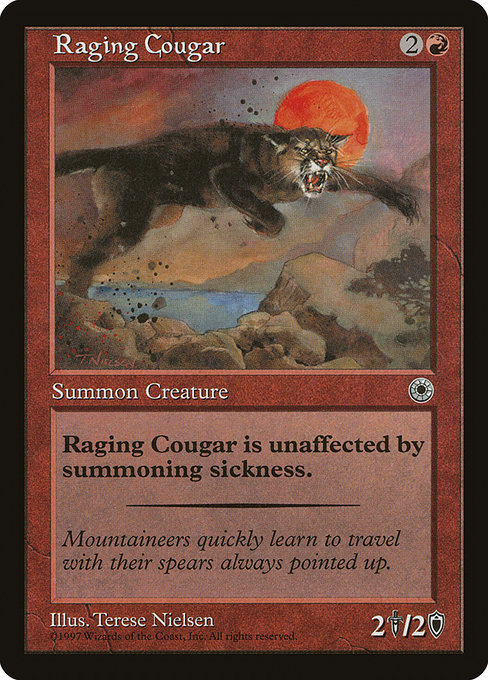
Image courtesy of Scryfall.com
Haste in MTG History: A Raging Cougar Welcome
Red has always been the daredevil of Magic: The Gathering, the color that says “attack now, ask questions later.” The tour through MTG history usually starts with tempo and risk, and one tiny creature with a big attitude—Raging Cougar—points the way. This 1997 Portal common, a {2}{R} 2/2 with the singular keyword Haste, embodies a moment when players learned to value speed over subtlety. It’s a small card with a mighty idea: press the gas pedal early and keep the board under pressure while your opponent is still untapping lands and selecting their first spell. 🧙♂️🔥
Portal, the starter-focused set from the late 1990s, was designed as an entry point for new players. Its cards favored straightforward play patterns, and Raging Cougar fits that mission perfectly. A red creature with haste costs three mana total, which means you’re committing to a quick, aggressive plan rather than a grindy stalemate. The art by Terese Nielsen delivers a kinetic moment—the cougar in full sprint—capturing red’s impulse to strike and move on. The flavor text—“Mountaineers quickly learn to travel with their spears always pointed up.”—adds a rugged, frontier feel to a card that is anything but passive. 🎨⚔️
From a gameplay perspective, Raging Cougar is a teaching tool for understanding how haste changes the tempo of a match. In a world where most early blockers can set up a defense, a creature with haste surprises, forcing decisions before your opponent can settle into their plan. The 2/2 body isn’t enormous, but the surprise attack is often enough to push a game into the realm of “must-answer now.” This is classic red—risk and reward—where paying a small mana tax yields immediate pressure. It’s also a window into how the early MTG ecosystem balanced keyword power: haste is strong when you can deploy it swiftly, but it doesn’t come with evasion, protection, or lasting effect. You trade longevity for speed, and that tradeoff has shaped countless red decks in the decades since. 🔥
As we trace the evolution of keywords and mechanics, Raging Cougar sits at a constructive crossroads. The 1990s and early 2000s saw red’s pace being reinforced by direct damage, fast creatures, and effects that reward aggressive starts. While haste later evolved to appear on more complex bodies and alongside other mechanics (dash, alchemy-sparked innovations, and permanent removal windows), the spirit of this card—play fast, threaten early, finish quickly—remains a throughline. Modern red decks still crave tempo, but now they weave haste with other tools, including enter-the-battlefield effects and temporary buffs, to maximize pressure on turn three and beyond. 🧠💎
Collectors and players alike can appreciate Raging Cougar as a lens into card design history. Its slot in Portal—printed as a common and enjoying nonfoil status—speaks to the era’s emphasis on accessibility. The card’s price point, as cataloged in contemporary databases, sits modestly around a few quarters, reminding us that early staples often found life in casual play rather than tournament dominance. Yet the memory of that little 2/2 with speed remains a memorable illustration of red’s musical tempo: quick notes, loud crescendos, and the thrill of landing the strike when the opponent least expects it. 🧩
For modern feeds and deeper dives into how haste interacts with board state, it helps to consider how the concept has grown. In contemporary sets, haste is often the starting pistol for red’s turns, while other colors bring their own tempo shifts—blue’s permission, green’s ramp, black’s disruption, and white’s resilience. Even so, the core lesson from Raging Cougar endures: the best plays sometimes come in on legs of fire and speed, demanding that your opponent answer or concede the initiative. That’s the heartbeat of red’s legacy, a thrill that makes players grin as they swing for the fence. 🧙♂️🔥
As you build or revisit a red-focused deck, think about the moments when speed matters most. Early game aggression can steal games that slow-control crews expect to win, and a hand full of fast threats can turn a tense matchup into a one-turn lead. Raging Cougar isn’t the pinnacle of power, but its presence in Portal makes it a touchstone card for anyone tracing the lineage of haste—from its 1997 roots to today’s ever-evolving battlefield of speed and strategy. And if you’re digging into the tactile side of MTG—typing out mana curves, refining tempo, and savoring art that captures a moment in time—pair that experience with gear that keeps you comfortable while you plan your next big swing. This is where strategy meets comfort, where timeless magic meets a modern desk setup. 🧙♂️🎲
Product spotlight
To keep your drafting sessions, deck-building, and late-night brewing comfortable, consider upgrading your workspace with ergonomic gear that supports long play sessions. The ergonomic memory foam wrist rest mouse pad is a practical companion for navigating complex color identities, mana systems, and the dozens of card interactions you’ll encounter in a single session. It’s the kind of subtle upgrade that helps you stay sharp as you chase those tempo-based wins.
Ergonomic Memory Foam Wrist Rest Mouse PadMore from our network
- https://transparent-paper.shop/blog/post/red-beacon-at-2400-parsecs-guides-brightness-based-distance-for-a-37k-star/
- https://blog.rusty-articles.xyz/blog/post/when-parallax-fails-a-blue-white-giant-at-22-kpc/
- https://crypto-acolytes.xyz/blog/post/essential-minecraft-tnt-crafting-guide-quick-safe-explosions/
- https://blog.digital-vault.xyz/blog/post/screams-from-within-deck-tech-and-influencer-spotlight/
- https://blog.digital-vault.xyz/blog/post/smiting-helix-visual-composition-and-mtg-art-direction/